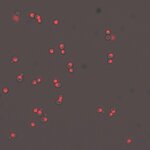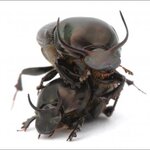Genetics & Molecular Biology

It is the concentration of a few signaling molecules that determines the fate of individual cells during the early development of organisms, say a team of molecular biologists writing in Current Biology. Pia Aanstad of the University of Innsbruck and colleagues report that a variety of molecular mechanisms accounts for the interpretation of the concentration of the signaling molecule Hedgehog.
The development of an organism is a complex process to which a dozen or hundreds of signaling molecules contribute. Some of these molecules have dozens of functions in the fruit fly and in…

Systems biology is a trendy field right now, but, despite the fact that it's hyped as some amazing, new, holistic approach to biology, the questions systems biologists are asking aren't new.
Check out this paper from 1985: a model of an extremely simple biological system that, in spite of its simplicity, senses its environment and makes decisions - lambda phage, a virus that infects bacteria.
Madeline Shea and Gary Ackers recognized that you can't understand why this system works the way it does by using intuitive, non-quantitative reasoning. They turned to a mathematical model, a…

You're sitting in a room filled with a gazillion air molecules - how likely is it that most of those air molecules will spontaneously end up in the corner of the room opposite of where you're sitting?
Most likely you're not too concerned about this scenario, because something like that, a massive fluctuation in the distribution of air molecules in the room, is extremely unlikely, to put it mildly.
When you have zillions of air molecules bouncing around in a room (zillions here being on the order of 10^28 molecules of the various gases that make up air), the fluctuations away from the average…

A class of drugs already approved as cancer treatments might also help to beat alcohol addiction. That's the conclusion of a discovery in flies of a gene, dubbed happyhour, that has an important and previously unknown role in controlling the insects' response to alcohol.
Animals with a mutant version of the gene grow increasingly resistant to alcohol's sedative effects, the research shows. The researchers report further evidence that the gene normally does its work by blocking the so-called Epidermal Growth Factor (EGF) pathway. That EGF pathway is best known for its role in cancer, and drugs…

Scientists sometimes regret when the terms they use in a scientific way get a colloquial meaning. In physics, Peter Higgs has to like his name recognition but might edit out references to a 'God particle' if he had it to do over again, and in biology a week doesn't go by that biologists won't complain that people misunderstand the term 'junk DNA.'
Well, 'junk' had a meaning before biology and everyone knew it - junk DNA in biology isn't garbage yet it dominates the genome and seems to lack specific functions. Why nature would force the genome to carry so much excess baggage is a puzzle…

Our genome is a patchwork of neighborhoods that couldn't be more different: Some areas are hustling and bustling with gene activity, while others are sparsely populated and in perpetual lock-down. Breaking down just a few of the molecular fences that separate them blurs the lines and leads to the inactivation of at least two tumor suppressor genes, according to researchers at the Salk Institute for Biological Studies.
Their findings published in the May 15, 2009 issue of Molecular Cell explain how a single event can put a cell well ahead on the road to becoming a tumor cell.
Normally, a…

A new report published in Cell says that a heart beat and blood circulation are critical signals for the production of blood-forming, or hematopoietic, stem cells in the developing embryo.
The evidence found in zebrafish and mice may lead to new methods to coax embryonic stem cell-like cells (known as induced pluripotent stem cells or iPS cells) into producing blood-forming stem cells for use in the clinic. Such a method could be a particular boon as an alternative source of life-giving cells for the two-thirds of people with leukemia who do not have a matched donor, typically a brother or…

Can fundamental genes acquire new functions? A new study in the Proceedings of the National Academy of Sciences by Indiana University Bloomington biologist Armin Moczek and research associate Debra Rose reports that two ancient genes were "co-opted" to help build a new trait in beetles -- the fancy antlers that give horned beetles their name. The genes, Distal-less and homothorax, touch most aspects of insect larval development, and have therefore been considered off-limits to the evolution of new traits.
In the two horned beetle species Moczek and Rose studied, the genetic sequences of…

As Feynman told the story in late 1959:
We have friends in other fields---in biology, for instance. We physicists often look at them and say, "You know the reason you fellows are making so little progress?" (Actually I don't know any field where they are making more rapid progress than they are in biology today.) ``You should use more mathematics, like we do." They could answer us---but they're polite, so I'll answer for them: "What you should do in order for us to make more rapid progress is to make the electron microscope 100 times better."
...It is very easy to answer many of these…

There's a line that politicians opposed to embryonic stem cell research have been peddling lately: recent breakthroughs in stem cell technology have now made ethically questionable embryonic stem cell research obsolete and unnecessary. This isn't a new line - for years, opponents of embryonic stem cell research have always claimed that the latest research (whatever it happens to be) has obviated the need for embryonic stem cells.
Two recent developments have brought this issue back into the public eye. President Obama rescinded Bush's executive order severely limiting federal funding for…